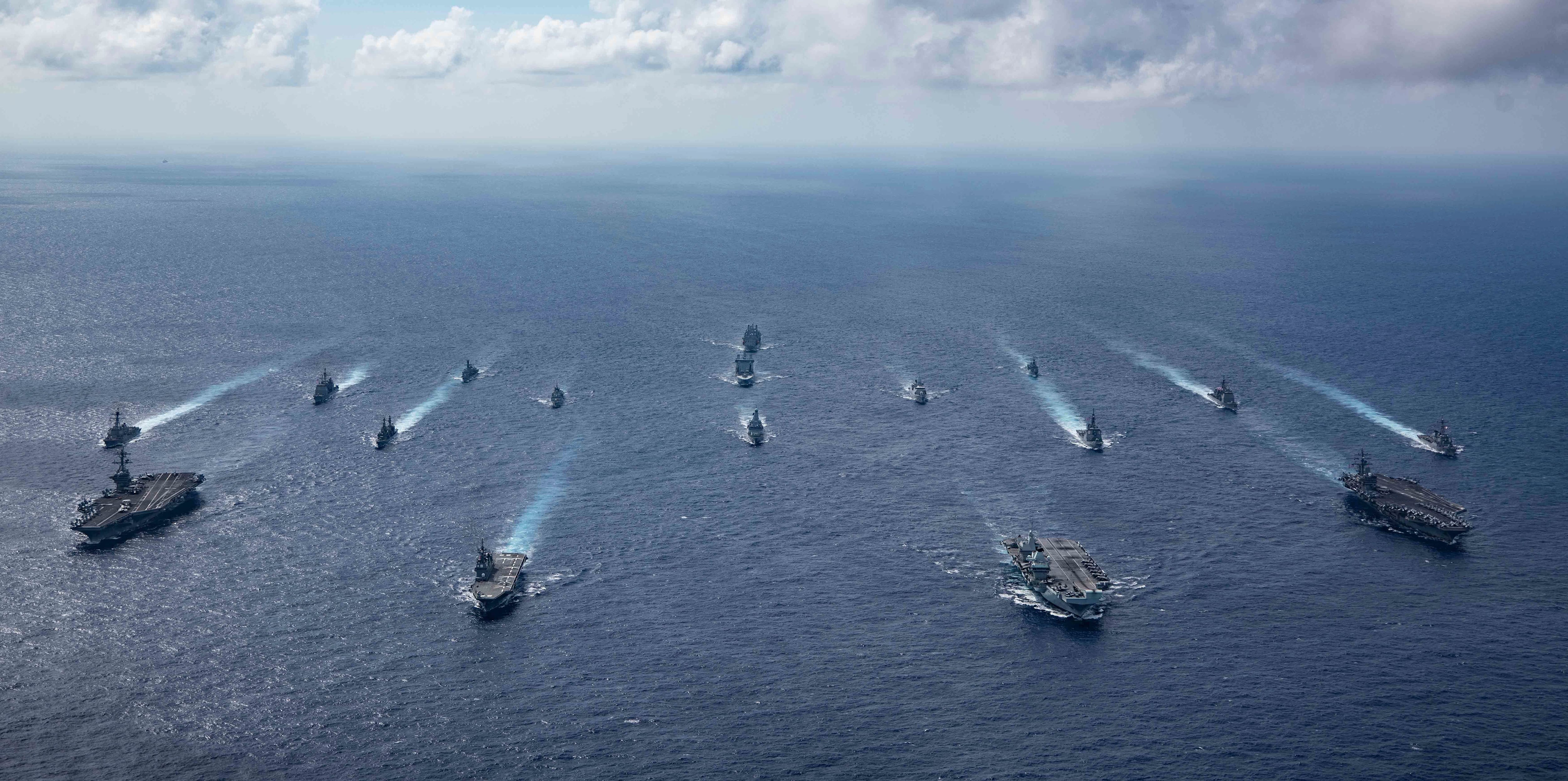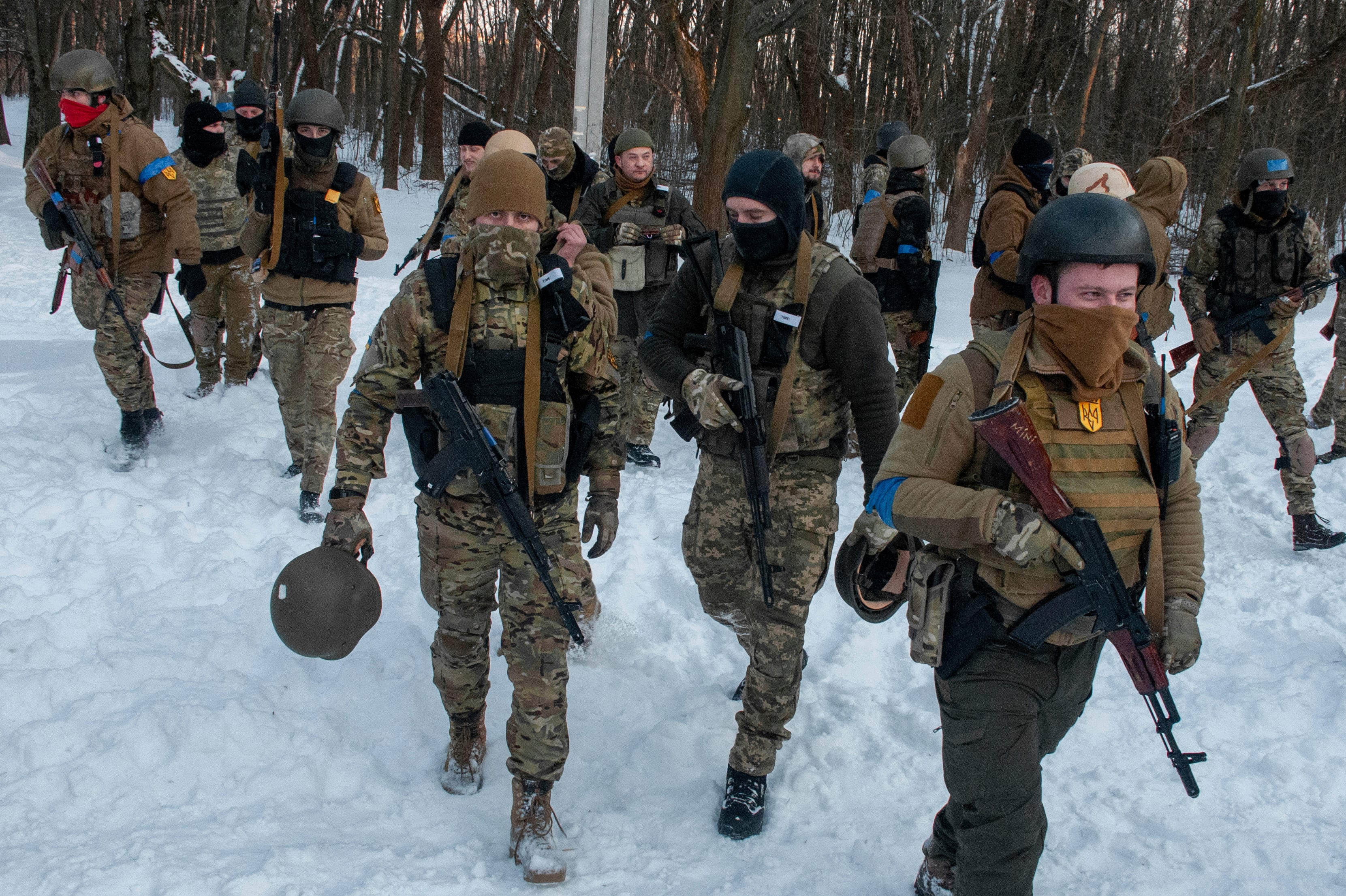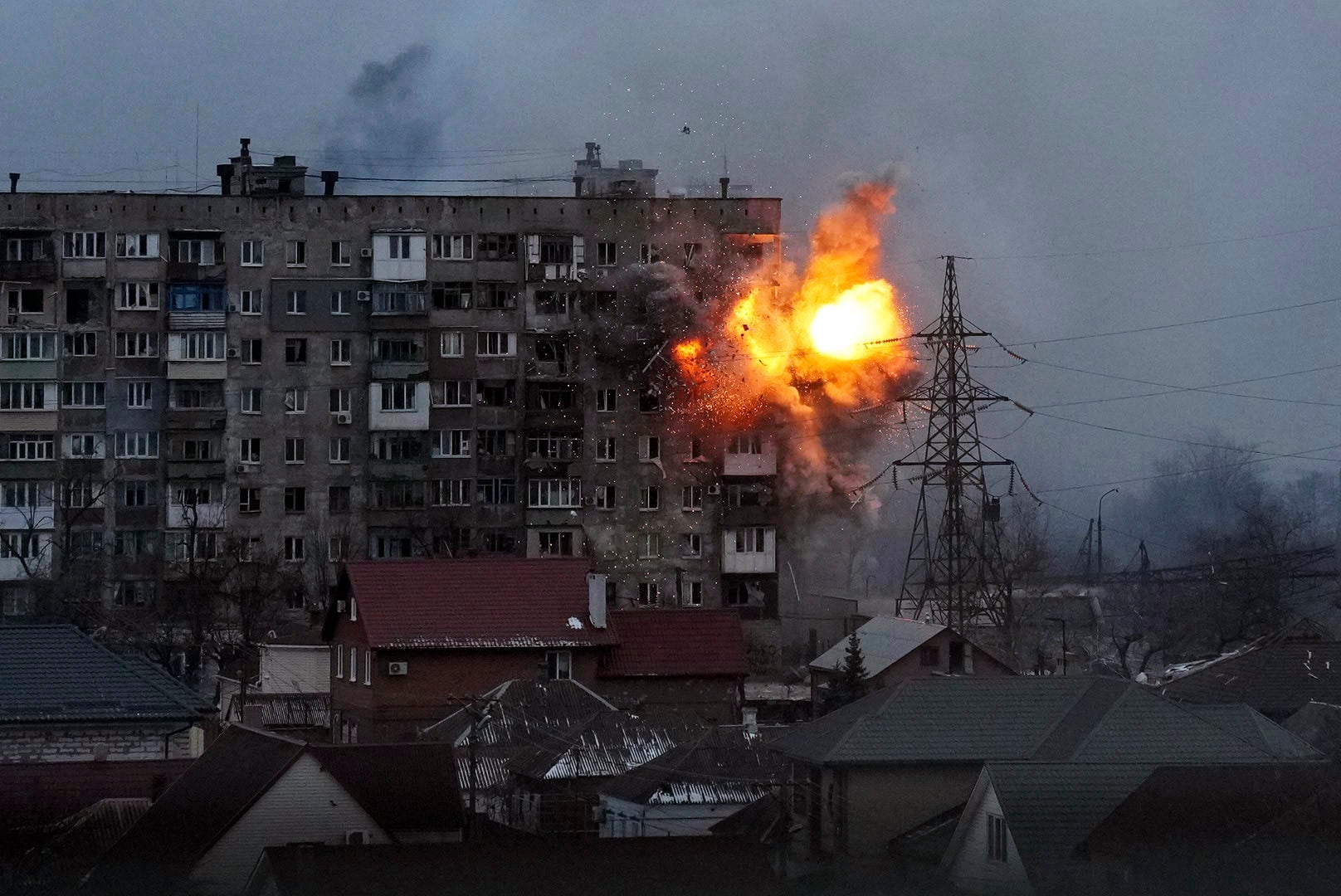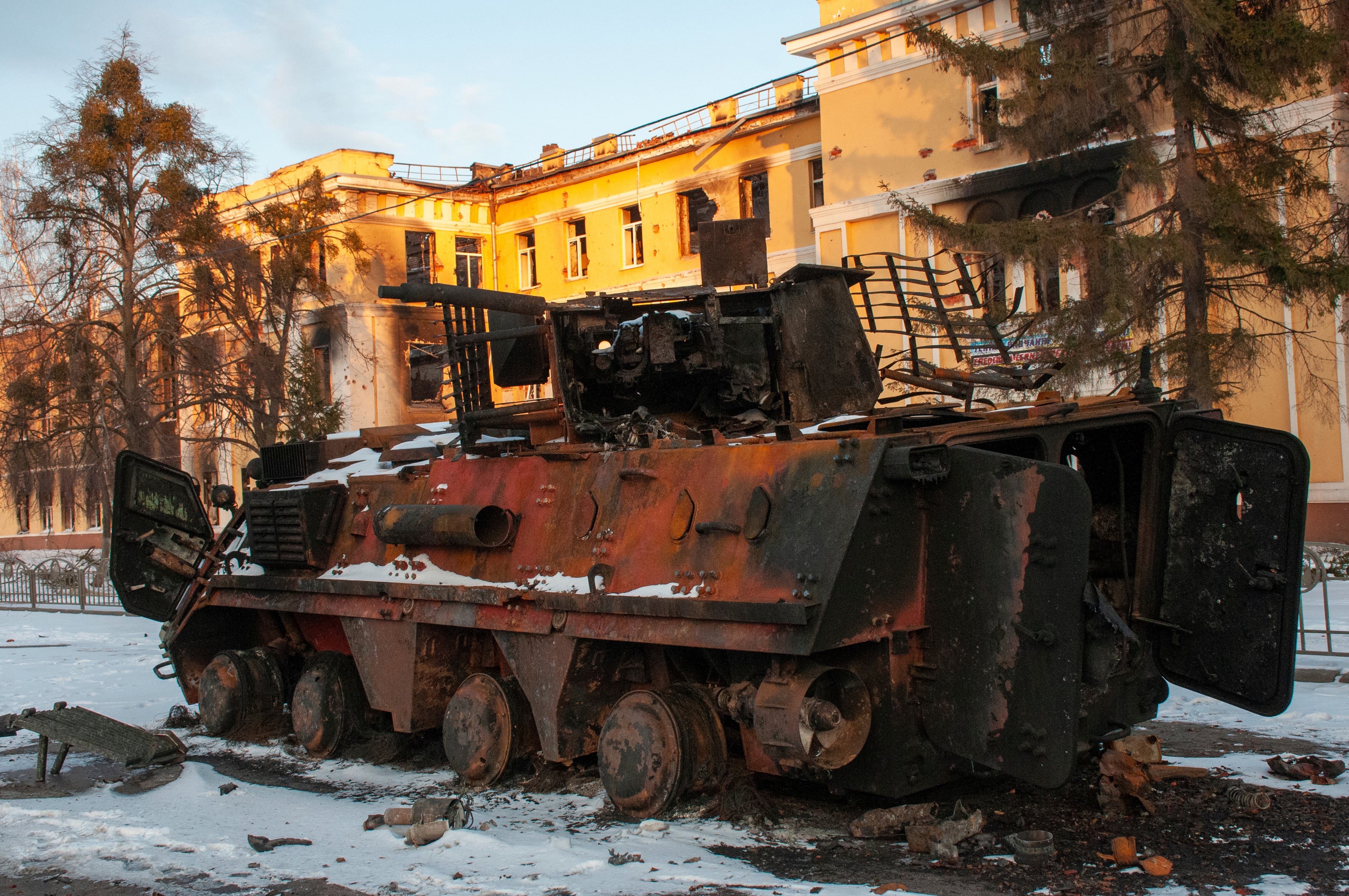Ukrainians are making Molotov cocktails, arming untrained civilians and deploying small units to strike Russian military vulnerabilities, slowing the invading army’s advance as they call upon the world for help.
Every effort is unlikely to provide a military victory over the country’s pending takeover by Russian forces. But with the right steps, experts said, each could be an investment in the future fight, buying a valuable commodity – time.
That’s because the best option for Ukrainians is to do what most overmatched adversaries of superpowers have been doing for more than a century: create a violent insurgency that will bleed Russian resources and drain their will to fight and occupy Ukraine, experts said.
RELATED

Simple moves such as putting disabled vehicles in major roadways or popping small arms fire whenever dismounted Russian troops are in the open early in the invasion impeded Russian military progress towards the capital.
Military Times interviewed veterans and national security experts who pointed to a number of key battles they’d personally fought in over the past 30 years and what Ukrainian fighters can learn from those techniques.
What follows are experience-driven tactics that those veterans saw through both training and combat, which proved successful both for them and against them.
In late February, the Russian military began its large-scale invasion of Ukraine. This came after Russia annexed Ukraine’s seaport of Crimea in 2014. Since then, Russians and Ukrainians fought each other in an ongoing hybrid war on the eastern edges of the country.
For the first weeks of the Russian invasion, the juggernaut’s advance was stymied by logistical problems, harassing attacks by the Ukrainian military and a poorly planned military operation, experts said.
But the early stumbles are already resolving as Russian forces have stepped up their use of more devastating weaponry and increased attacks on civilians, previewing even more at the devastation to come.
“The problem with this getting more lethal is you’re going to see extremes,” said Col. John Spencer, urban warfare training director for the Army National Guard’s 40th Infantry Division.
While Russians may allow time for civilians to leave a city they’ve surrounded, once they’re gone, every Ukrainian with a weapon is a target.

“Every mile, every hour they take to get there will make it harder to take the city,” Spencer said, a veteran of the Iraq invasion and urban fighting in Baghdad. “Turn every possible entryway into Kyiv into a nightmare situation. Turn it into Mosul for the Iraqi military.”
The Battle of Mosul lasted more than nine months from 2016 to 2017. Estimates show more than 1,200 allied killed, 5,000 wounded, as many as 11,000 civilians and 5,000 Islamic State fighters killed.
Accurate numbers are hard to confirm, but in only the first three weeks of the Russian-Ukrainian war, hundreds of Ukraine military and civilians have perished and as many as 2,000 to 4,000 Russian soldiers have died.
The battle of Mosul essentially annihilated the city. Many fear such a future for Ukraine’s cities.
Make a stand
Roman Fontana, a former enlisted U.S. Marine of Ukrainian descent, traveled to Ukraine in 2015 after his military service to help its officers build better battle plans.
Fontana told Military Times that shoulder-fired missiles, man-portable air defense, ammunition and artillery pieces would give Ukrainian fighters the tools they need.
While Ukrainians have had some success knocking out Russian vehicles in poorly defended convoys, that tactic will prove more difficult as Russians consolidate gains and bring more weaponry to bear outside of cities.
“There’s no terrain relief at all,” Fontana said. Much of the countryside is flat farmland with few places to hide other than some scattered tree lines.
Beyond weapons, basic survival items such as food, water and medical help are crucial for any sustained Ukrainian resistance.
“My major concern is consistent resupply,” Fontana said.
Outside supporters need a way to funnel humanitarian relief to Ukrainians being cut off from the rest of the world.
“Ideally we need a Berlin Airlift with the Red Cross,” Fontana said, referring to the nearly year-long relief effort started in 1948 by the United States to bring supplies to German civilians trapped behind Soviet lines in post-World War II Berlin.
Olin Rossman retired as an Army sergeant first class after an infantry career with early exposure to urban fighting as a squad leader for 3rd Platoon, Charlie Company, 1st Battalion, 87th Regiment, 10th Mountain Division in the Battle of Mogadishu, Somalia in 1993.

That battle later made famous by the book and movie, “Black Hawk Down,” was a kind of harbinger of the intensity and complexity of modern urban combat for advanced militaries facing entrenched militias or insurgencies.
Rossman and his fellow infantrymen first faced an intense skirmish following the September 1993 crash of the first Black Hawk helicopter in Mogadishu, weeks before the infamous downing of two Army helicopters that led to the death of 19 U.S. soldiers, some of the most highly trained, Rangers and Delta Force operators.
The infantryman and his comrades were part of the force that went in to evacuate the trapped Rangers and operators. Rossman noticed how Somali militia members adjusted their tactics on the ground and used unsophisticated, but effective methods to blunt the high-tech, highly-trained U.S. forces.
“The Somalis would set up roadblocks, nothing but burning tires, donkey carts, stuff like that,” Rossman said.
Marine veteran Evan McAllister served multiple combat tours in Iraq and Afghanistan as a sniper and later a reconnaissance team leader.
“There’s very little they can do to prevent a city from being completely destroyed if a large, mechanized force attempts to capture it,” McAllister said.
But if given enough time to prepare, the defenders making a stand can do the following:
- Place many obstacles on main roads into cities and at dense points within urban areas.
- Construct and camouflage fighting positions inside buildings and near roadblocks for quick ambushes.
- Design and rehearse a series of alternate and supplementary positions, so-called “kill boxes” to unleash focused, violent attacks on isolated Russian troops.
- Create expedient “fallback routes” to shoot and move from those hasty ambushes to set up the next attack and drawn in more Russian forces.
Those steps require little refined military training and more a knowledge of the local terrain, which Ukrainians have, he said.
Rossman told Military Times that while in Mogadishu, the U.S. practice at that time when deploying their own roadblock was to include an “overwatch” – a sniper, machine gunner or mortar team that would strike any adversary stalled at that position.
So his soldiers assumed that every roadblock contained the same kind of opposition. That meant stopping and often exiting their vehicles to check out the burning tires or other obstacles.
Those practices slowed advances into the crowded city to a crawl.
This looks like what Russians have faced over the past week as they reach the Ukrainian cities, the Wall Street Journal reported.
U.S. soldiers in Somalia learned quickly to blow through or divert around roadblocks, which Russians are likely doing as the fighting grinds on, experts said.
While U.S. soldiers brought close air support and small arms to the fight, they held back armor, artillery or larger-scale bombing in Mogadishu.
That wasn’t the case for the 2003 Iraq invasion, which saw heavy but precise strikes at key Iraqi nodes.
Still, the U.S. military advance mostly skirted or bypassed towns in southern Iraq on its way to the capital of Baghdad to “decapitate” command and control of the Iraqi military.
Hit the flanks
Bypassing towns was the chief method for the speed with which the United States reached and took over Baghdad with many fewer casualties in its 2003 Iraq invasion. And that’s some of what Wade Spann, a Marine veteran of the invasion, the first Battle of Fallujah and the Battle of Ramadi, saw on his invasion deployment.
While skirting towns gave Americans a speed advantage, they weren’t immune to having exposed flanks and attacks in the rear. That’s another lesson Ukrainians can use. Even if Russian tanks blow past a village, the supply trucks following behind can be hit, having a real effect on fighting at the front.
U.S. Army and Marines hit resistance at Nasiriyah, Iraq only a few days into the war that resulted in the deaths of 32 U.S. troops and the capture of Army Pfc. Jessica Lynch and five other soldiers.
The initial ambush and a subsequent friendly fire strike disabled eight Marine amphibious assault vehicles during the fighting, which initially slowed invasion advances.
“A lot of people are going to be really upset when Russia drops its hammer,” Spann told Military Times. “Ukrainians have them bogged down. But I remind people it took us three weeks to get to Baghdad and we had overwhelming superiority on the ground.”
From media reports and observations, Spann said it didn’t appear the Russians had used their more advanced and devastating weaponry during the first days of fighting.
Based off Russian tactics in one of its own republics, Chechnya, and its assistance to the Bashar al-Assad regime in Syria, the idea is often to encircle a city or area, allow noncombatants to exit by a deadline then level areas block by block with withering barrages of artillery, armor and air strikes. Such attacks on civilian centers, churches and administrative buildings ratcheted up in the past week, according to media reports.
“That, to me, might be a viable action for the Russian military,” Spann said.
He added that if he were on the ground with Ukrainians he would want to obtain as many antitank weapons as possible to keep Russian mechanized forces bogged down.
While there hasn’t been much talk publicly yet about improvised explosive devices, Spann and others expect IEDs to come into the mix, especially during any kind of Ukrainian insurgency to a Russian occupation.
“What effective was the (Iraqi) insurgency against us?” Spann said. “They just had artillery shells, fuses and timers”
Study Russia’s recent urban tactics
If past Russian battles of the post-Soviet Union period are any indication, any early missteps in Ukraine will lead to swift and devastating corrections in the coming days and weeks. Some of these may have already occurred with media reports of Russian strikes on civilian communication nodes and the use of cluster bombs and thermobaric weapons, which create a vacuum sucking out oxygen in the vicinity of the blast, suffocating victims.
The first few days of reports from Ukraine invasion included poorly trained and ill-prepared Russian conscripts leaving the fight or being captured. But the introduction of elite Russian soldiers such as their special operations forces, the Spetsnaz, and other hardened fighters portends a more steeled and likely brutal response.
In 1994 the Russian Army invaded the Grozny, the capital of the Chechen Republic of Ichkeria, a republic within the post-Soviet Russian Federation.
This first major combat foray of the Russian military post-Cold War saw its forces initially humiliated. Chechen fighters used urban guerilla tactics to hit unprepared Russian units hard, killing as many as 2,000 Russian soldiers in the early phase of the eventual two-month battle.
The United States saw 1,847 troops killed on hostile action over its nearly 20-year campaign in Afghanistan, according to the Pentagon’s Feb. 28, 2022, casualty status report.
The Russian military took Grozny at a high cost. But its leaders also took notes.

In 1999 Russian troops again laid siege to Grozny. Again, the fighting lasted about two months.
That time, however, Russian military units devastated the city. Accurate figures are hard to verify, but reports indicate an estimated 5,000 to 8,000 Chechen civilians were killed, along with as many as 2,000 Chechen combatants. The Russians lost 368 troops, according to media reports at the time.
In 2016, Russia conducted massive aerial bombardments of Aleppo, Syria in their military support of dictator Bashar al-Assad’s attacks on his own people. Russian strikes targeted schools, hospitals and food distribution centers, according to media reports.
Many analysts and regional experts commented throughout the Russian involvement in the war in Syria that Russian President Vladimir Putin was using the conflict as a kind of testbed for military tactics.
Recent reports indicate that Russian officials are recruiting Syrian allies with urban combat experience to fight in Ukraine, especially to take the capital city of Kyiv, according to the Wall Street Journal.
The civilian fighter role
Untrained civilians have answered the call from Ukrainian leaders have for civilian fighters, taking up arms, according to media reports, to fight the Russian threat.
But more realistically, Spann said, it’s the trained Ukrainian military that will be most effective at actual combat, he said. Especially those who’ve spent the past eight years fighting Russian proxies in the Donbas region.
The civilian population, young and old, can help in other ways.
Fontana said many of the smaller villages are no more than 2 to 5 km apart and under old Soviet rule residents? served as “reporters” gathering information to pass to a kind of regional commander.
Rather than a 75-year-old woman picking up an AK-47, citizens in a similar demographic might serve better as a moving listening and observation posts, tracking Russian soldier numbers and equipment movement, Fontana said.
While morale remains high, Rossman said that Ukrainian leaders need to leverage civilian support, but do it in a smart way.
That’s because if Ukrainian citizens line up to aid in the fight and are not used, that’s going to destroy their morale, Rossman said.
Though many may recoil at the thought, children will likely figure into the mix in some way.
In other parts of the world where extended militia or terrorist group attacks are more common, insurgents and militias see children as another combat tool.
“Having been shot at by a kid, it is not something I like,” Rossman said. “But kids universally are ignored on the battlefield until something happens.”
Go underground, build the resistance
Making a do-or-die stand today might seem brave or foolhardy, depending on the outcome. Most urban combat veterans and experts interviewed saw a mix of both from Ukrainian fighters.
McAllister said Ukrainians would be best to go straight to deceptive guerilla tactics rather than trying to make symbolic stands and getting surrounded by Russian forces.
That’s in part because Russian tactics typically keep them mounted and mechanized and it’s unlikely that the Ukrainians have effective counter-battery artillery assets or close air support needed to destroy those platforms, he said.
Constant small-unit ambushes on Russian infantry vehicles and supply convoys.
“I would want to use my home field advantage to remain mobile, difficult to locate and blended into the countryside and only engage enemy forces when the situation is at my advantage,” McAllister said.
Like Spann, McAllister said that anti-tank rockets and guided missiles along with repurposed conventional artillery that could be turned into IEDs would be among the best options.
All of those actions keep with future goals for an eventual Ukrainian resistance.
The seeds for such a resistance may have already been planted.
Army Times reported last year about broader U.S. Army efforts to refocus Special Forces operators into aiding European allies such as the Republic of Georgia and Ukrainian neighbors using a revamped “Resistance Operating Concept.”
Secretary of the Army Christine Wormuth last year pointed to the Baltic region as an area ripe for resistance aid and training, another counter-Russian flank for the United States and Europe to exploit.
And there’s a literal playbook.
The 286-page ROC manual on the Joint Special Operations University website takes notes from past resistance efforts such as the French Resistance during WWII.
But such efforts can take years to bear fruit, dragging out the suffering of the occupied people.
Ukrainian combat experience and preparations since 2014 might help, as will actions taken this past week. Leaders can build old fashioned word-of-mouth networks, for example.
Rian Madden a former Marine infantryman who deployed in the 2003 Iraq invasion and fought in Ramadi, Iraq said accounts he’s seen so far show that the Ukrainians understand basic urban fighting tactics.
Those include creating obstructions for high speed avenues of approach, such as highways and main roads in cities.
By doing that, fighters can create a “channelizing effect” which would cause the Russian convoys to flow into choke points or urban valleys where they can be bombed or subject to small arms fire.
Ukrainians know how to employ enfilade fire with machine guns, missiles and rockets to reduce the Russian armor advantage, Madden said.
That creates a “major stoppage point,” he said.
Their infantry then has to bounce building to building, firing and moving, which will require Russians to get out of their vehicles and clear buildings.
“It’s going to be extremely difficult as they try to do that,” Madden said.
It will get worse
Madden hadn’t yet seen full-scale barrages of fire from Russian units reported when interviewed during the second week of fighting.
Though attacks have since escalated, the Russian forces have not yet turned to old Soviet tactics of, “turning two grid squares into a parking lot” Madden said.
That means the Ukrainians have some time on their side.
McAllister agreed that looming artillery and missile attacks present truly crushing effects, but there are ways to operate even in those withering attacks.
“More artillery is always bad but artillery needs to have a target,” McAllister said.
Ukrainian fighters must also remain wary of Russian troops employing precision fire, night vision and thermal optics to hit targets at all hours and overhead drones.
Small units have to retain their ability slip away amid assaults and mount a counterattack that surprises Russian adversaries when they’re vulnerable.
The Ukrainians are making this invasion hurt the Russian military. With the right manuevers they can put in place structures to make an occupation as painful.
But whichever direction the conflict takes, too many people will die and everyone will lose much on the way to its end.
“No matter how well the defenders prepare, full-scale urban combat will be extremely horrendous for both sides,” McAllister said.
Todd South has written about crime, courts, government and the military for multiple publications since 2004 and was named a 2014 Pulitzer finalist for a co-written project on witness intimidation. Todd is a Marine veteran of the Iraq War.





